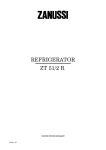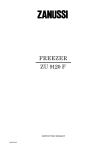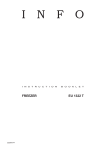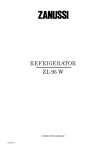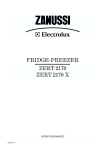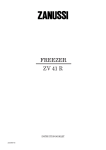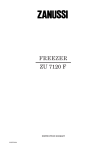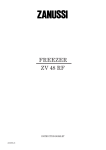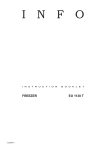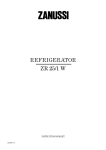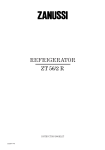Download Zanussi ZFX 74 W Freezer User Manual
Transcript
FREEZER ZFX 74 W INSTRUCTION BOOKLET 2222693-26 CONTENTS Instructions for the User Instructions for the Installer Important Safety Instructions 3 Technical Specifications 13 Description of the Appliance 4 Installation 13 Operation 5 Positioning Door reversal Before use Starting your appliance Temperature control Internal thermometer Freezing fresh food Frozen food storage Freezing calendar Thawing Ice making Automatic defrost Normal operating sounds 5 5 5 5 6 6 6 6 6 6 7 Health and Safety Guidelines 8 Maintenance and Cleaning 9 Internal cleaning External cleaning When the appliance is not in use 9 9 9 Something Not Working? 10 Service and Spare Parts 11 Customer Care Department 11 Guarantee Conditions 12 Electrical Connection 2 13 14 15 IMPORTANT SAFETY INSTRUCTIONS These warnings are provided in the interests of your safety. Ensure that you understand them all before installing or using this appliance. Your safety is of paramount importance. If you are unsure about any of the meanings of these warnings contact the Customer Care Department. Prior to Installation ■ General Safety Check the appliance for transport damage. Under no circumstance should a damaged appliance be installed. In the event of damage please contact your retailer. ■ ■ Installation ■ This appliance is heavy. Care should be taken when moving it. ■ It is dangerous to alter the specifications or attempt to modify this product in any way. ■ Ensure that the appliance does not stand on the electrical supply cable. Important: if the supply cable is damaged, it must be replaced by a cable available from the manufacturer or your local Service Force Centre. Any electrical work required to install this appliance should be carried out by a qualified electrician or competent person. ■ ■ ■ ■ ■ ■ During Use Parts which heat up should not be exposed. Whenever possible, the back of the appliance should be close to a wall, but leaving the required distance for ventilation, as stated in the installation instructions. The appliance should be left for 2 hours after installation before it is turned on, in order to allow the refrigerant to settle. Refrigerant ■ ■ ■ The refrigerant isobutane (R600a) is contained within the refrigerant circuit of the appliance, a natural gas with a high level of environmental compatibility, which is nevertheless flammable. During transportation and installation of the appliance, be certain that none of the components of the refrigerant circuit become damaged. If the refrigerant circuit should become damaged: - avoid open flames and sources of ignition. - thoroughly ventilate the room in which the appliance is situated. ■ This appliance is designed for domestic use only, specifically for the storage of edible foodstuffs. It is not intended for commercial or industrial use. ■ Containers with flammable gases or liquids can leak at low temperatures. Do not store any containers with flammable materials, such as spray cans, fire extinguisher refill cartridges etc. in the freezer. ■ Frozen food should not be refrozen once it has thawed out. ■ Do not place carbonated or fizzy drinks in the freezer compartment. ■ Ice lollies can cause ‘frost/freezer burns’ if consumed straight from the freezer. ■ Do not remove items from the freezer compartment if your hands are damp/wet, as this could cause skin abrasions or frost/freezer burns. ■ Placing frozen goods on the top of the appliance can lead to the accumulation of condensation in the cavity of the storage tray through contact with the cold. Electronic components are housed within this cavity. If condensation should drip onto these components, the appliance could be damaged by a short circuit. For this reason do not place frozen goods on top of the appliance. ■ Bottles and cans must not be placed in the freezer as they can burst when the contents freeze. Child Safety ■ Do not allow children to tamper with the controls or play with the product. ■ There is a risk of suffocation! Keep packaging material away from children! This appliance contains hydrocarbons in its cooling unit; maintenance and recharging must therefore only be carried out by authorised technicians. Take utmost care when handling your appliance so as not to cause any damages to the cooling unit with consequent possible fluid leakages. The appliance must not be located close to radiators or boilers. Avoid prolonged exposure of the appliance to direct sunlight. Do not use other electrical appliances (such as ice cream makers) inside of refrigerating appliances. 3 ■ Manufacturers’ recommended storage times should be adhered to. Refer to relevant instructions. At the end of the Appliance Life Maintenance and Cleaning ■ Before cleaning, always switch off the appliance and disconnect from the electrical supply. ■ When unplugging always pull the plug from the mains socket, do not pull on the cable. ■ When disposing of your appliance use an authorised disposal site. ■ Remove the plug and ensure that any locks or catches are removed, to prevent young children being trapped inside. Servicing ■ This product should be serviced by an authorised engineer and only genuine spare parts should be used. ■ Under no circumstances should you attempt to repair the appliance yourself. Repairs carried out by inexperienced persons may cause injury or serious malfunctioning. Contact your local Service Force Centre. DESCRIPTION OF THE APPLIANCE ➀ ➀ ➁ ➂ 6 5 4 Freezer controls 1 2 3 -16 -24 -22 °C -18 -20 Compartment for freezing fresh food Comparments for storing frozen food ➂ ➂ ➂ ➁ Your appliance is frost free, which means there is no need to manually defrost your appliance as this will be carried out automatically. 4 OPERATION Before use Remove all securing tapes. Wash inside the appliance with lukewarm water and bicarbonate of soda (5 ml to 0.5 litre of water). Do not use soap or detergent as the smell may linger. Dry thoroughly. Freezer controls -16 -24 °C -18 -22 -20 ➀ ➁ ➂ ➃ ➀ Pilot light (green) ➁ Thermostat control knob ➂ Fast-freezing indicator light (yellow) ➃ Push button for fast-freezing Starting your appliance Insert the plug into the wall socket. The appliance can be activated by turning the thermostat knob beyond the “-16°C” position. When the pilot light is illuminated this shows that the appliance is on. The freezer is switched off by turning knob to position «●». control to the higher numbers; to obtain a higher temperature turn the control to the lower numbers. When altering the temperature setting, allow 24 hours for the temperature to stablise before making further changes. ➁ ➀ ➁ Freezing fresh food Temperature control In any 24 hour period you can freeze up to 9 kg of fresh food. Activate fast freeze by depressing the fast freeze button ➃ - for more than one second - 24 hours before you want to freeze your fresh food, the yellow light ➂ illuminates. This time can be shortened depending on the quantity of food to be frozen. After the time has elapsed place the food to be frozen in the bottom drawer of the freezer as this is the coldest part. The maximum amount of food which can be frozen in 24 hours is indicated on the rating plate. This is to be found on the bottom left-hand side. You should never freeze all at once a greater quantity of foods than the maximum indicated on the appliance’s rating plate. The temperature inside the freezer is regulated by a thermostat with 5 temperature positions and one «OFF» (●) position. Position «-16°C» = minimum cold Position «-24°C» = maximum cold Turn the thermostat dial to the required position. An intermediate position (-18°C) is usually the most suitable, although the temperature will be affected by: Room temperature l How often the door is opened l How much food is stored l Position of the appliance In determining the correct temperature control setting all these factors have to be considered and some experimentation may be necessary. To obtain a lower temperature, turn the thermostat l 5 Once the food is completely frozen (which could take up to 24 hours) the fast freeze function can be ended manually at any time by depressing the button ➃ again for more than one second. The yellow light goes out. If the fast freeze function is not ended manually, the appliance electronics switch off the fast freeze function after 48 hours. The yellow goes out. light Distribute the frozen food packages in the other compartments, so that the bottom drawer can be used for a further freezing operation. Only freeze top quality, fresh and thoroughly cleaned foodstuffs. During the freezing process, ensure that the freezer door remains closed. Because freezing is faster with frost free technology, once food is defrosted, it retains all of its original texture, vitamins and taste. In the event of a power failure the appliance automatically starts again in fast freeze mode. If the fast freeze function is not ended manually, the appliance electronics switch off the fast freeze function after 5 hours. The yellow light goes out. ➂ ➂ Freezing calendar The symbols on the drawers show different types of frozen goods. The numbers indicate storage times in months for the appropriate types of frozen goods. Whether the upper or lower value of the indicated storage time is valid depends on the quality of the foods and pretreating before freezing. Thawing Frozen food storage Frozen food, prior to being used, can be thawed in the fridge or at room temperature depending on the time available. Small food items may even be cooked from frozen; in this case cooking will take longer. Any frozen food which is allowed to thaw accidentally should either be eaten as soon as possible or thrown away. Alternatively, if the food is uncooked and has not been completely defrosted it can be cooked and then refrozen. Defrosted cooked food must never be refrozen. When you first start the freezer or if the freezer has been out of use for some time, we advise you to run your appliance for at least two hours in the «fast freeze» mode before storing frozen food. To obtain the best performance from this appliance, we suggest that all of the internal baskets are utilized. Moreover, we strongly recommend that you make sure that the commercially frozen foodstuffs were adequately stored by the retailer and, furthermore, be sure that these frozen foodstuffs are transferred from the foodstore to your freezer in the shortest possible time (a temperature increase of the frozen food could shorten its storage period). It is also advisable not to exceed the storage period indicated by the producer of the food. To ensure the correct functioning of the appliance, no foodstuffs should be stored directly against the fan blade. Finally, do not open the door frequently or leave it open longer than is absolutely necessary. Making ice cubes The appliance is provided with a plastic ice cube tray. Fill the tray 3/4 full to allow the ice to expand and place it in the freezer. To turn out the ice cubes simply give the tray a slight twist to release the cubes. Never tray to free an ice tray that is frozen to the freezer using a sharp or pointed object. Automatic defrost Important Do not put carbonated liquids, (fizzy drinks etc.), in the freezer. Ice lollies, if consumed immediately after removal from the freezer, can possibly result in a low temperature skin burn. Do not remove items from the freezer if your hands are damp/wet, as this could cause skin abrasions or "frost/freezer burns". If there is a power failure during the storage of frozen food, do not open the door during the whole time of the power failure. If the freezer is fully loaded, the frozen food will not be affected if the power cut is of short duration; otherwise, it is recommended to consume the food within a very short time. Your appliance has been designed to be frost free. This means there is no need to manually defrost your appliance as this will be carried out automatically. 6 Normal operating sounds The advanced design of today’s frost free appliances mean you hear unfamiliar noises during everyday operation. The diagrams below describe some of the noises you may hear. These are quite normal and mean your appliance is operating correctly. COOLING FAN You may hear the cooling air being blown inside the cabinet by the fan. The flow of liquids and gases through the cooler may create a bubbling or gurgling sound. During normal operations movement caused by temperature change may cause sudden sharp sounds. DRAIN PAN Water may occasionaly be heard running into the drain pan. MOTOR Modern, high efficiency motors operate much faster than older models. The motor may have a high pitched hum or pulsating sound. 7 HEALTH AND SAFETY GUIDELINES Because of consumer demand, preservatives have been removed from many pre-prepared foods. This together with the changes in shopping habits to a once-a-week shop, mean that safe handling and storage of food is even more important than ever. The following tips should help you to ensure that the food in your home is in as perfect condition as possible. ■ ■ ■ ■ ■ ■ ■ ■ ■ ■ Keep the freezer door closed as much as possible. Do not push food together too much, try to allow air to circulate around each item. Cool cooked food as quickly as possible but do NOT place in the freezer until cool. (Leave food in a place as cool as possible in order that it can then be placed in the refrigerator as soon as possible). Do not store food uncovered. The best way to defrost food is to put it in the refrigerator to thaw slowly. Ensure that food placed in the freezer is dated and labelled and used in date order to ensure that food is consumed at its best. It is important that food is used before its “best before” date. Always wash your hands with soapy water and dry them with a clean towel before handling food. Keep work surfaces clean and avoid cross contamination by not using the same work surface or knife, without washing them thoroughly in between. The foods to be frozen must be fresh and of the best quality. ■ ■ ■ ■ ■ ■ The size of each pack should be small enough to ensure that it is used in one go. Small packs freeze more quickly and uniformly and give better results. Frozen food, once thawed, must not be refrozen. Lean food keeps better and longer than fatty food, salt reduces the storage time. Wrap the food in polythene or aluminium freezing bags or foil so that they adhere to the food and provide an airtight seal. Packaging which is swollen or has traces of refrozen water droplets on the pack could indicate that the product has not been kept at a suitable temperature and that it may have lost its original quality. Partially thawed food must not be refrozen, it must be consumed within 24 hours. Never exceed the storage time indicated. Never place hot food, bottles or cans of fizzy drink in the freezer as they may explode. Containers with a lid must not be filled to the brim. Do not open the door or place extra fresh food in the freezer next to food which is already frozen as this could cause the temperature of the frozen food to rise and its quality and storage life to reduce. Important In the event of a power failure causing the temperature within your freezer to rise, do not refreeze the food without checking its condition. The following guidelines should assist you: Ice-cream: once thawed should be discarded. Fruits & Vegetables: if soft should be cooked and used up. Breads & Cakes: can be re-frozen without danger. Shellfish: should be refrigerated and used up quickly. Cooked Dishes: i.e. casseroles should be refrigerated and used up. Large Pieces of Meat: can be re-frozen providing there are still ice crystals remaining within them. Small Joints: should be cooked and can then be re-frozen as cooked dishes. Chicken: should also be cooked and re-frozen as a cooked dish. 8 MAINTENANCE AND CLEANING Before any maintenance or cleaning work is carried out, DISCONNECT the appliance from the ELECTRICITY supply. Warning This appliance contains hydrocarbons in its cooling unit maintenance and recharging must therefore only be carried out by authorised technicians. Internal cleaning Clean the inside and accessories with warm water and bicarbonate of soda (5ml to 0.5 litre of water). Rinse and dry thoroughly. NEVER USE DETERGENTS, ABRASIVE POWDERS, HIGHLY PERFUMED CLEANING PRODUCTS OR WAX POLISHES, TO CLEAN THE INTERIOR AS THESE WILL DAMAGE THE SURFACE AND LEAVE A STRONG SMELL. Important Do not use abrasive products. External cleaning Wash the outer cabinet door with warm soapy water. Do NOT use abrasive products. Once or twice a year dust the condenser (black grill) and the compressor at the back of the appliance, with a brush or vacuum cleaner, see figure. You MUST ensure that the appliance is switched OFF. An accumulation of dust will affect the performance of the appliance and cause excessive electricity consumption. CONDENSER DEFROST TRAY COMPRESSOR D662 When the appliance is not in use When the appliance is not in use for long periods, disconnect from the electricity supply, empty all foods and clean the appliance, leaving the door ajar to prevent unpleasant smells. 9 SOMETHING NOT WORKING? Before contacting your local Service Force Centre check the following points. IMPORTANT: If you call out an engineer to a fault listed below, or to repair a fault caused by incorrect use or installation, a charge will be made even if the appliance is under guarantee. Symptom Solution No power to the appliance - Check there is power at the socket. - Check there is not a power cut by checking the household lights. - Check the fuse has not blown. The temperature in the freezer is too high - Check the thermostat control knob is turned to the correct setting relative to ambient conditions. - Check the ambient temperature is within the appliances operating limits of 10°C to 32°C. - Relocate the appliance if necessary. The freezer door will not open - Has the door just been opened? - If so leave for a few minutes to allow the air pressure to equalise. The compressor runs continuously - Adjust the thermostat control knob to give correct temperature control. See page 5. - Check that the door is closed. - Large quantities of food have recently been placed in the cabinet and/or door is frequently opened. - Check that air ventilation is not obstructed. The freezer flaps have frost and ice on. - Ensure the door is not left opened. - Check that nothing is preventing the door from closing. - Is the door gasket intact and clean? Noise Refer to normal operating sounds. If after the above checks, there is still a fault, call your local Service Force Centre. In-guarantee customers should ensure that the above checks have been made as the engineer will make a charge if the fault is not a mechanical or electrical breakdown. Please note that proof of purchase is required for any in-guarantee service calls. 10 SERVICE AND SPARE PARTS In the event of your appliance requiring service, or if you wish to purchase spare parts, please contact your local Service Force Centre by telephoning:- When you contact the Service Force Centre you will need to give the following details: 1. Your name, address and post code 2. Your telephone number 3. Clear and concise details of the fault 4. The model and serial number of the appliance (found on the rating plate) 5. The purchase date 08705 929929 Your telephone call will be automatically routed to the Service Force Centre covering your post code area. For the address of your local Service Force Centre and further information about Service Force, please visit the website at www.serviceforce.co.uk Please note that a valid purchase receipt or guarantee documentation is required for in-guarantee service calls. Before calling out an engineer, please ensure you have read the details under the heading “Something Not Working.” CUSTOMER CARE DEPARTMENT For general enquiries concerning your Zanussi appliance or for further information on Zanussi products, please contact our Customer Care Department by letter or telephone at the address below or visit our website at www.zanussi.co.uk Customer Care Department Zanussi 55-77 High Street Slough Berkshire SL1 1DZ 08705 727727 (*) * calls to this number may be recorded for training purposes. 11 GUARANTEE CONDITIONS Standard guarantee conditions We, Zanussi, undertake that if within 12 months of the date of purchase this Zanussi appliance or any part thereof is proved to be defective by reason only of faulty workmanship or materials, we will, at our option repair or replace the same FREE OF CHARGE for labour, materials or carriage on condition that: ■ The appliance has been correctly installed and used only on the electricity supply stated on the rating plate. ■ er's The appliance has been used for normal domestic purposes only, and in accordance with the manufacturinstructions. ■ The appliance has not been serviced, maintained repaired, taken apart or tampered with by any person not authorised by us. ■ All service work under this guarantee must be undertaken by a Zanussi Service Force Centre. ■ Any appliance or defective part replaced shall become the Company's property. ■ This guarantee is in addition to your statutory and other legal rights. Home visits are made between 8.30am and 5.30pm Monday to Friday. Visits may be available outside these hours in which case a premium will be charged. Exclusions This guarantee does not cover: ■ Damage or calls resulting from transportation, improper use or neglect, the replacement of any light bulbs or removable parts of glass or plastic. ■ Costs incurred for calls to put right an appliance which is improperly installed or calls to appliances outside the United Kingdom. ■ Appliances found to be in use within a commercial environment, plus those which are subject to rental agreements. ■ Products of Zanussi manufacture which are not marketed by Zanussi. European Guarantee If you should move to another country within Europe then your guarantee moves with you to your new home subject to the following qualifications: ■ The guarantee starts from the date you first purchased your product. ■ The guarantee is for the same period and to the same extent for labour and parts as exists in the new country of use for this brand or range of products. ■ This guarantee relates to you and cannot be transferred to another user. ■ Your new home is within European Community (EC) or European Free Trade Area. ■ The product is installed and used in accordance with our instructions and is only used domestically, i.e. a normal household. ■ The product is installed taking into account regulations in your new country. Before you move please contact your nearest Customer Care centre, listed below, to give them details of your new home. They will then ensure that the local Service Organisation is aware of your move and able to look after you and your appliance. France Germany Italy Sweden UK Senlis Nürnberg Pordenone Stockholm Slough +33 +49 +39 +46 +44 (0) (0) (0) (0) (0) 3 44 62 29 29 800 234 7378 0434 39 4700 8 672 53 90 1753 219897 12 TECHNICAL SPECIFICATIONS DIMENSIONS Height Width Depth POWER SUPPLY VOLTAGE AND FREQUENCY TOTAL POWER ABSORBED AVERAGE DAILY UNITS ELECTRICITY(*) 220-240 V / 50 Hz 90 W 0,77 kWh GROSS CAPACITY 100 l (3,54 cuft) 80 l (2,82 cuft) NET CAPACITY 85 59.5 60 cm cm cm STAR RATING (*)This figure is based on standard test results in accordance with the European Standard EN153. Actual consumption will depend on how the appliance is used and where it is located. INSTALLATION Positioning A B 10 mm 10 mm 50-100 mm For this appliance to work efficiently, it must not be located where the temperatures will fall below 10°C (50°F) or rise above 32°C (90°F), e.g. conservatories. For correct operation this appliance must be located in a dry atmosphere, away from heat sources, e.g. cookers, radiators, boilers and direct sunlight. You should also ensure that air can circulate freely around the back and the top of the cabinet. There should be 100mm (4”) between the top of the cabinet and any overhanging kitchen furniture. Alternatively allow 50mm (2”) between the top of the cabinet and any overhanging kitchen furniture and a gap of 25mm (1”) on either side of the appliance. Do not obstruct the space underneath. The back of the cabinet may be placed close to the wall but must not touch it. DO NOT install in places with restricted ventilation. Adjust the level of the appliance by screwing out the adjustable foot, or feet, at the bottom of the cabinet using your fingers. NP006 D200 13 Door Reversal Before carrying out the operations described below, pull out the mains plug from the wall socket. To carry out this reversal go through the following steps: 1. Gently lay the appliance on its back with the top held away from the floor by 5-8 cm (2-3 inches) of packing. 2. Remove the bottom door hinge (5). 3. Remove the door (4) by opening it and pulling it gently downwards to remove it from the top hinge pin (2). 4. Unscrew the top hinge pin (2) from the top hinge (1) and replace it in the opposite hole on the left hand side. 5. Unscrew the foot at the base (6) of the appliance and refit it on the opposite side. 6. Refit the door and the bottom hinge to the left hand side. When positioning the bottom hinge blade on the reverse side, the securing screws will require a degree of force when fitting. It is therefore advisable to lubricate the screw tips before starting this operation. Important After completion of the door reversal operation, verify that the door gasket is sealing onto the cabinet. If the ambient temperature is cold (i.e. in Winter), the gasket may not fit perfectly to the cabinet. In that case, wait for the natural fitting of the gasket or accelerate this process by heating up the part involved with a normal hairdryer on a low setting. 14 ELECTRICAL CONNECTION This appliance complies with the following E.E.C. Directive: - 73/23 EEC of 19.2.73 (Low Voltage Directive) and subsequent amendments. - 87/308 EEC of 2.6.87 relative to radio interference suppression and subsequent amendments. - 89/336 EEC of 3.5.89 (Electromagnetic Compatibility Directive) and subsequent amendments. WARNING: THIS APPLIANCE MUST BE EARTHED. The manufacturer declines any liability should this safety measure not be observed. If the plug that is fitted to your appliance is not suitable for your socket outlet, it must be cut off and the appropriate plug fitted. Remove the fuse from the cut off plug. The cut off plug should then be disposed of to prevent the hazard of shocks in case it should be plugged into a 13amp socket in another part of your home. Please ensure that when the appliance is installed it is easily accessible for the engineer in the event of breakdown. Important The wires in the mains lead are coloured in accordance with the following code: Green and Yellow Blue Brown - Earth - Neutral - Live If you fit your own plug, the colours of the wires in the mains lead of your appliance, may not correspond with the markings identifying the terminals in your plug, proceed as follows: Connect the Green and the Yellow (earth) wire to the terminal in the plug which is marked with the letter «E» or the earth symbol , or coloured green and yellow. 13 AMP. FUSE 13 AMP GREEN & YELLOW Connect the blue (neutral) wire to the terminal in the plug which is marked with the letter «N» or coloured black. BROWN BLUE Connect the brown (live) wire to the terminal in the plug which is marked with the letter «L» or coloured red. D207 The plug moulded onto the lead incorporates a fuse. For replacement, use a 13amp BS1362 fuse. Only ASTA or BSI approved fuses should be used. The plug must not be used if the fuse cover/carrier is lost. The cover/carrier is indicated by the coloured insert at the base of the plug. A replacement cover/carrier must be obtained from your local Service Force Centre. 15 CORD CLAMP © Electrolux plc 2002
















